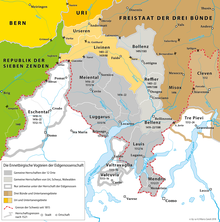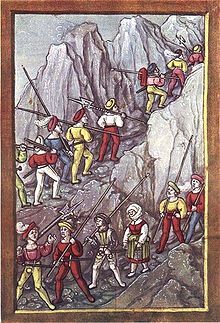You can help expand this article with text translated from the corresponding article in German. (January 2021) Click [show] for important translation instructions.
|
The transalpine campaigns of the Old Swiss Confederacy (German: Ennetbirgische Feldzüge, "transmontane campaigns", as they are known in Swiss historiography) were military expeditions which resulted in the conquest of territories south of the Alps, corresponding more or less to the modern canton of Ticino, on the part of the Old Swiss Confederacy in the 15th and 16th centuries. These territories were known as ennetbirgische Vogteien or "transmontane bailiwicks".


History of the campaigns
editThe Leventina was the first transalpine possession of the Swiss cantons of Uri and Obwalden, acquired in 1403. Other territories were acquired in 1418 and 1419. A first setback came with the Battle of Arbedo in 1422, where the Swiss were defeated by the Duchy of Milan, and in a treaty of 1426, the border of the duchy was moved back to the Gotthard Pass. Renewed campaigns took place in 1439, 1441 and 1447, until in 1449 the Swiss were beaten again by troops of the Golden Ambrosian Republic in the Battle of Castione.[1]
In 1466, the duke of Milan promised to grant the Leventina to the confederates, but he was slow to act on his promise, and as the Swiss were tied up in the Burgundian Wars he even formed a pact with the Burgundians. This prompted Uri to send an expedition to the Leventina, which was greeted as liberators by the local population. The Swiss tried to conquer Bellinzona as well, but after a two weeks' siege gave up and returned home. The Battle of Giornico was for once a Swiss victory, in which a force of Uri of about 175 men, with the support of about 400 men from the local population, managed to rout a Milanese army of 10,000.[citation needed] From this time, the Leventina was an undisputed possession of Uri, while Bellinzona remained under Milanese control.
In 1487, the Valais together with Lucerne wanted to expand into the Ossola. Besieging Domodossola and marauding the valleys, the Swiss were decisively defeated by the Duchy of Milan army at the Battle of Crevola in April 1487.
This was the situation at the beginning of the Italian Wars in 1494. Bellinzona was finally occupied by Uri in 1500, and officially granted to the confederacy by Louis XII of France in 1503. The Battle of Novara (1513) was a success for the Swiss Confederacy and the allied Three Leagues which secured their possessions of Locarno, Lugano, Mendrisio, Cuvio, Travaglia, Chiavenna, Bormio, Tre pievi and Valtellina. The defeat in the Battle of Marignano (1515) set an end to Swiss aspirations to further extend their possessions, but the peace of 1516 allowed them to keep their possessions, except for Ossola which was handed back to Milan.
These ennetbirgische Vogteien were governed partly by the entire confederacy, partly just by Uri, Schwyz and Nidwalden (and the Leventina just by Uri) throughout the early modern period. The Valtellina, governed by the Three Leagues from 1512, was lost to Spain in the course of the Bündner Wirren, in 1639.
Transalpine bailiwicks
editOverview of the transalpine bailiwicks (German: Ennetbergische Vogteien, Italian: Baliaggi Ultramontani):
Condominiums of the Forest cantons of Uri, Schwyz and Nidwalden:
- Blenio — 1477–80 and from 1495
- Riviera — 1403–22 and from 1495
- Bellinzona — from 1500
Condominiums of the Twelve Cantons (Zwölf Orte, the Thirteen Cantons, minus Appenzell) from 1512:
Condominiums of the Twelve Cantons from 1512, but were lost from the Confederacy three years later and are now comuni of Lombardy and Piedmont:
See also
editReferences
edit- ^ Maffioli, Alessandra (2003-09-09). "Castione, battaglia di" (in Italian, German, and French). www.hls-dhs-dss.ch. Retrieved 23 August 2011.
- Hans Stadler: Ennetbirgische Feldzüge in German, French and Italian in the online Historical Dictionary of Switzerland.
- W. Ehrenzeller, Die Feldzüge der Walliser und Eidgenossen ins Eschental und der Wallishandel 1484-1494 (1912).